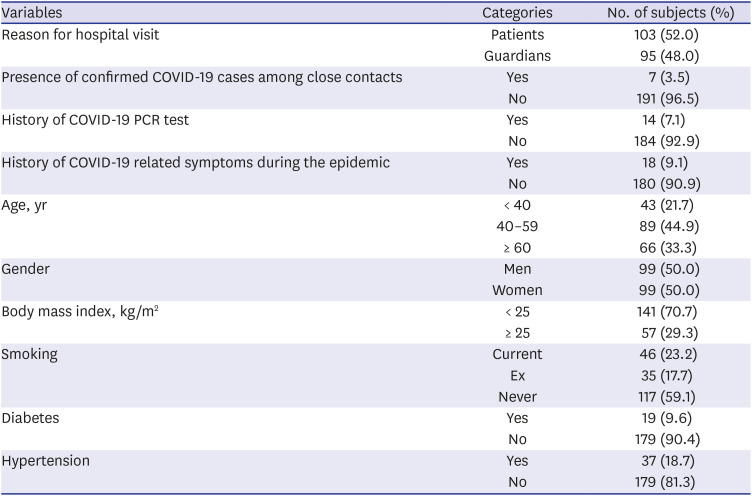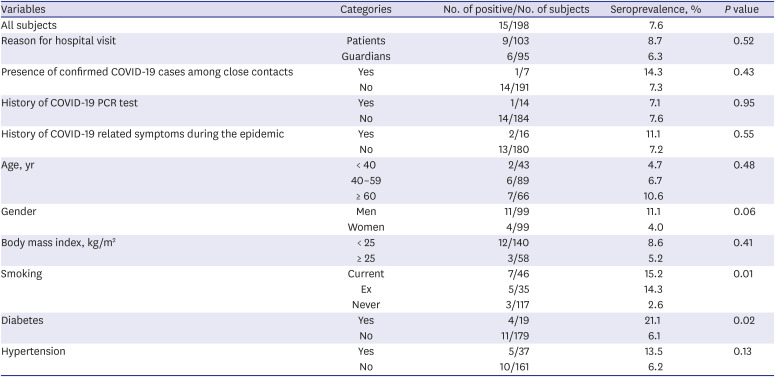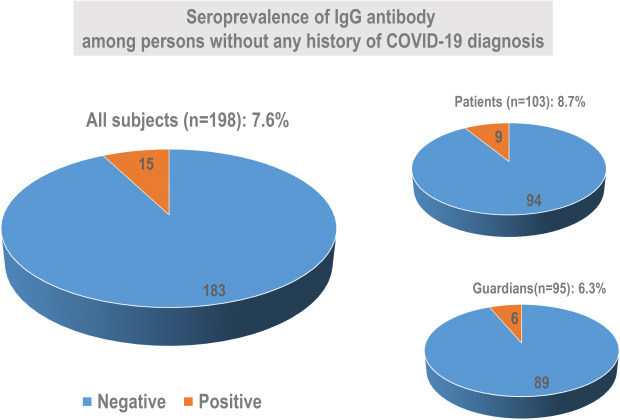2. Korean Society of Infectious Diseases. Korean Society of Pediatric Infectious Diseases. Korean Society of Epidemiology. Korean Society for Antimicrobial Therapy. Korean Society for Healthcare-associated Infection Control and Prevention. Korea Centers for Disease Control and Prevention. Report on the epidemiological features of coronavirus disease 2019 (COVID-19) outbreak in the Republic of Korea from January 19 to March 2, 2020. J Korean Med Sci. 2020; 35(10):e112. PMID:
32174069.
3. Bryant JE, Azman AS, Ferrari MJ, Arnold BF, Boni MF, Boum Y, et al. Serology for SARS-CoV-2: apprehensions, opportunities, and the path forward. Sci Immunol. 2020; 5(47):eabc6347. PMID:
32430309.

4. Shakiba M, Hashemi Nazari SS, Mehrabian F, Rezvani SM, Ghasempour Z, Heidarzadeh A. Seroprevalence of COVID-19 virus infection in Guilan province, Iran. Updated 2020. Accessed June 5, 2020. DOI:
10.1101/2020.04.26.20079244.
5. Bryan A, Pepper G, Wener MH, Fink SL, Morishima C, Chaudhary A, et al. Performance characteristics of the Abbott Architect SARS-CoV-2 IgG Assay and seroprevalence in Boise, Idaho. J Clin Microbiol. 2020. JCM.00941-20.

6. Stringhini S, Wisniak A, Piumatti G, Azman AS, Lauer SA, Baysson H, et al. Repeated seroprevalence of anti-SARS-CoV-2 IgG antibodies in a population-based sample from Geneva, Switzerland. Updated 2020. Accessed June 5, 2020. DOI:
10.1101/2020.05.02.20088898.
7. Doi A, Iwata K, Kuroda H, Hasuike T, Nasu S, Kanda A, et al. Estimation of seroprevalence of novel coronavirus disease (COVID-19) using preserved serum at an outpatient setting in Kobe, Japan: a cross-sectional study. Updated 2020. Accessed June 5, 2020. DOI:
10.1101/2020.04.26.20079822.
8. Erikstrup C, Hother CE, Pedersen OB, Mølbak K, Skov RL, Holm DK, et al. Estimation of SARS-CoV-2 infection fatality rate by real-time antibody screening of blood donors. Clin Infect Dis. 2020; ciaa849. PMID:
32584966.

9. Fontanet A, Tondeur L, Madec Y, Grant R, Besombes C, Jolly N, et al. Cluster of COVID-19 in northern France: a retrospective closed cohort study. Updated 2020. Accessed June 5, 2020. DOI:
10.1101/2020.04.18.20071134.
10. Wu X, Fu B, Chen L, Feng Y. Serological tests facilitate identification of asymptomatic SARS-CoV-2 infection in Wuhan, China. J Med Virol. 2020; DOI:
10.1002/jmv.25904.

11. Slot E, Hogema BM, Reusken CB, Reimerink JH, Molier M, Karregat JH, et al. Herd immunity is not a realistic exit strategy during a COVID-19 outbreak. Updated 2020. Accessed June 5, 2020. DOI:
10.21203/rs.3.rs-25862/v1.
12. Streeck H, Schulte B, Kuemmerer B, Richter E, Hoeller T, Fuhrmann C, et al. Infection fatality rate of SARS-CoV-2 infection in a German community with a super-spreading event. Updated 2020. Accessed June 5, 2020. DOI:
10.1101/2020.05.04.20090076.
13. Silveira M, Barros A, Horta B, Pellanda L, Victora G, Dellagostin O, et al. Repeated population-based surveys of antibodies against SARS-CoV-2 in Southern Brazil. Updated 2020. Accessed June 5, 2020. DOI:
10.1101/2020.05.01.20087205.
14. Thompson C, Grayson N, Paton R, Lourenço J, Penman B, Lee LN, et al. Neutralising antibodies to SARS coronavirus 2 in Scottish blood donors - a pilot study of the value of serology to determine population exposure. Updated 2020. Accessed June 5, 2020. DOI:
10.1101/2020.04.13.20060467.
15. Bendavid E, Mulaney B, Sood N, Shah S, Ling E, Bromley-Dulfano R, et al. COVID-19 antibody seroprevalence in Santa Clara County, California. Updated 2020. Accessed June 5, 2020. DOI:
10.1101/2020.04.14.20062463.
16. Bai Y, Yao L, Wei T, Tian F, Jin DY, Chen L, et al. Presumed asymptomatic carrier transmission of COVID-19. JAMA. 2020; 323(14):1406–1407.

17. Sanche S, Lin YT, Xu C, Romero-Severson E, Hengartner N, Ke R. High contagiousness and rapid spread of severe acute respiratory syndrome coronavirus 2. Emerg Infect Dis. 2020; 26(7):1470–1477. PMID:
32255761.

18. Wilder-Smith A, Chiew CJ, Lee VJ. Can we contain the COVID-19 outbreak with the same measures as for SARS? Lancet Infect Dis. 2020; 20(5):e102–7. PMID:
32145768.

19. Mallapaty S. Will antibody tests for the coronavirus really change everything? Nature. 2020; 580(7805):571–572. PMID:
32313159.

20. Vogel G. First antibody surveys draw fire for quality, bias. Science. 2020; 368(6489):350–351. PMID:
32327574.

21. Kontou PI, Braliou GG, Dimou NL, Nikolopoulos G, Bagos PG. Antibody tests in detecting SARS-CoV-2 infection: a meta-analysis. Diagnostics (Basel). 2020; 10(5):319.

22. Randolph HE, Barreiro LB. Herd immunity: understanding COVID-19. Immunity. 2020; 52(5):737–741. PMID:
32433946.

23. Kwok KO, Lai F, Wei WI, Wong SY, Tang JW. Herd immunity - estimating the level required to halt the COVID-19 epidemics in affected countries. J Infect. 2020; 80(6):e32–3. PMID:
32209383.

24. Gomes MG, Corder RM, King JG, Langwig KE, Souto-Maior C, Carneiro J, et al. Individual variation in susceptibility or exposure to SARS-CoV-2 lowers the herd immunity threshold. Updated 2020. Accessed June 5, 2020. DOI:
10.1101/2020.04.27.20081893.
25. Leslie M. T cells found in coronavirus patients ‘bode well’ for long-term immunity. Science. 2020; 368(6493):809–810. PMID:
32439770.

26. Grifoni A, Weiskopf D, Ramirez SI, Mateus J, Dan JM, Moderbacher CR, et al. Targets of T cell responses to SARS-CoV-2 coronavirus in humans with COVID-19 disease and unexposed individuals. Cell. 2020; 181(7):1489–1501.e15. PMID:
32473127.





